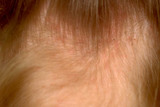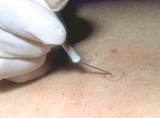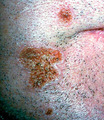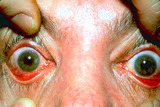The Health Education Assets Library (HEAL) is a collection of over 22,000 freely available digital materials for health sciences education. The collection is now housed at the University of Utah J. Willard Marriott Digital Library.
TO
Filters: Collection: ehsl_heal
| Title | Description | Subject | Collection | ||
|---|---|---|---|---|---|
| 101 |
 |
Excision: suturing | The second throw is initiated by placing the needle holder on the inside the long arm (needle bearing end) of the V. | Knowledge Weavers Dermatology | |
| 102 |
 |
Excision: suturing vertical mattress | When the long arm (needle bearing end) of the suture is held upward, it forms a natural V, and the needle holder is placed on the inside the long arm of the V. | Knowledge Weavers Dermatology | |
| 103 |
 |
Excision: vertical mattress suture | This demonstrates placement of the vertical mattress suture that is used to close the upper layer of the dermis and the epidermis.The first pass the needle enters the right side of the wound about 2 mm from the wound, penetrates the full thickness of the dermis and exits 2 mm from the wound edge on... | Knowledge Weavers Dermatology | |
| 104 |
 |
Fibrous septae | Fibrous septae connect the dermis to the underlying fascia, and these fibrous septaeoften have to be cut during surgery to free the wound edges in order to be able to pull the wound together and close it with suture. | Surgical Methods | Knowledge Weavers Dermatology |
| 105 |
 |
Flea bites | Presumed flea bites. | Knowledge Weavers Dermatology | |
| 106 |
 |
Fleas | The flea. These have been shown to live up to 40 days without a blood meal. The major disease we see in the Intermountain West that is carried by fleas is plague, and this is actually seen very rarely. | Knowledge Weavers Dermatology | |
| 107 |
 |
Forceps | The forceps are held with the non-dominant hand as shown here between the first two or three fingers. | Knowledge Weavers Dermatology | |
| 108 |
 |
Freezing with liquid nitrogen | Freezing is done to mainly destroy epidermal growths. As long as the indicated freezing times are followed, generally there is no scarring. Occasionally the dermis is injured as shown here, and hypertrophic or keloid scars can be formed, especially on areas of tension, such as the elbow. | Knowledge Weavers Dermatology | |
| 109 |
 |
Goodman | This is a picture of Dr. Goodman (of Goodman & Gillman fame). I once asked him how much you should know about a medication before using it, and he said,A lot! And you can quote me on that! | Knowledge Weavers Dermatology | |
| 110 |
 |
Hair regrowth | Rogaine helps to restore hair regrowth of some degree in about a third of men. | Dermatology; Hair | Knowledge Weavers Dermatology |
| 111 |
 |
Halogenated steroids | Halogenated steroids, particularly fluorinated steroids, will often induce inflammation of the skin of the scrotum, vulvae, as well as the face. Halogenated steroids should never be used, with rare exception, on these areas, and then for the briefest period of time possible. | Knowledge Weavers Dermatology | |
| 112 |
 |
Halogenated steroids | Halogenated steroids, particularly fluorinated steroids, applied to the facial skin for over several weeks will often induce a dermatitis around the mouth, nose, and lower eyelids; this is called periorificial dermatitis. This inflammation usually, but not always, resolves spontaneously within seve... | Knowledge Weavers Dermatology | |
| 113 |
 |
Head lice | On close inspection one could often see the adult lice as shown here. | Knowledge Weavers Dermatology | |
| 114 |
 |
Head lice | Infestation with head lice at the nape of the neck produces redness and scaling of the skin, and the black/brown/gray nits (eggs) can be seen on the hair shafts, and occasionally the adult lice can be seen on the skin. | Knowledge Weavers Dermatology | |
| 115 |
 |
Head lice | Infestation with head lice. Generally, there is dermatitis at the nape of the neck, and the itching tends to be accentuated there. | Knowledge Weavers Dermatology | |
| 116 |
 |
Head lice | On close observation, you can often see the adult lice as, but it is much easier to see the pinhead size nits on the scalp hair. | Knowledge Weavers Dermatology | |
| 117 |
 |
Hyfrecator: burning skin lesions | When using the hyfrecator one should ensure that it is plugged into low, and for small growths a setting of 30 (3 watts) is used, and on larger growths a setting of 50 (5 watts) is used. | Hyfrecator | Knowledge Weavers Dermatology |
| 118 |
 |
Impetigo | Infection just beneath the stratum corneum of streptococcus or staphylococcus is called impetigo. The stratum corneum is readily torn off, and generally the serous ooze from the dermal blood vessels dries on the skin and produces a honey-colored crust. | Knowledge Weavers Dermatology | |
| 119 |
 |
Incompetent venous system of the legs | The next step in damage to the skin from an incompetent venous system of the legs is lipo dermatosclerosis. In this condition, there is an increased amount of fibrous tissue both within the dermis and the underlying fat. The extremities appear tense and shiny, and they feel woody and hard to the tou... | Knowledge Weavers Dermatology | |
| 120 |
 |
Inflamed bulbar conjunctivae secondary to rosacea | Inflamed bulbar conjunctivae secondary to rosacea. | Knowledge Weavers Dermatology | |
| 121 |
 |
Ingrown nail | The nail plate is cut from the underlying nail bed with scissors. | Knowledge Weavers Dermatology | |
| 122 |
 |
Ingrown nail | This shows the nail plate just barely attached. | Surgical Methods | Knowledge Weavers Dermatology |
| 123 |
 |
Ingrown nail | 90% phenol is one of the agents advocated for destroying the nail matrix that grows at the base of the cul-de-sac beneath the proximal nail fold. | Knowledge Weavers Dermatology | |
| 124 |
 |
Ingrown nail | This demonstrates local infiltration of the skin around the nail. It is crucial to inject slowly and to advance the needle slowly. I found local infiltration to be superior to a digital block. | Knowledge Weavers Dermatology | |
| 125 |
 |
Ingrown nail | This shows the nail plate and part of the attached matrix having been removed. | Knowledge Weavers Dermatology |
